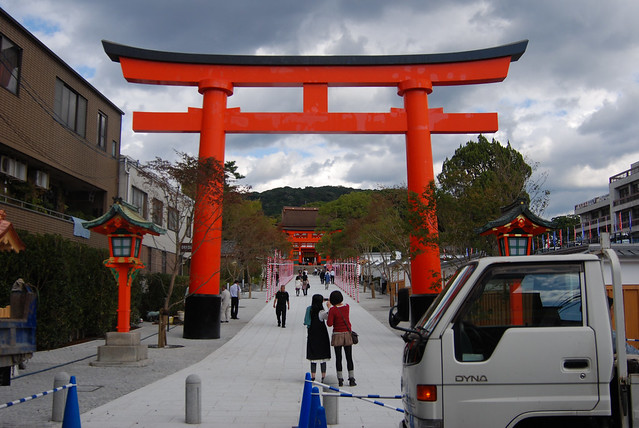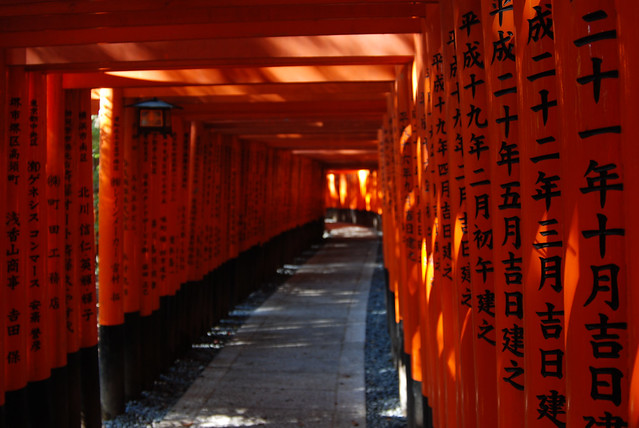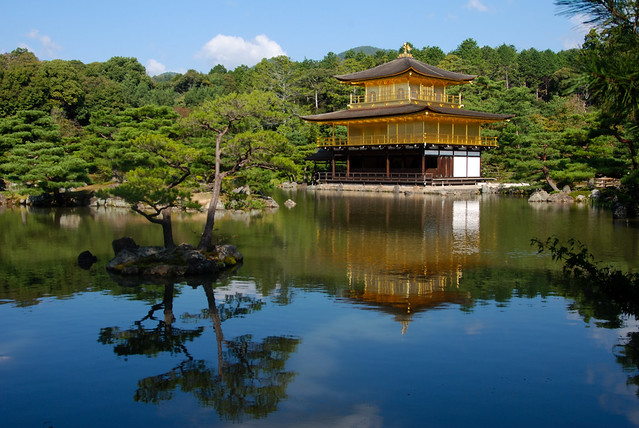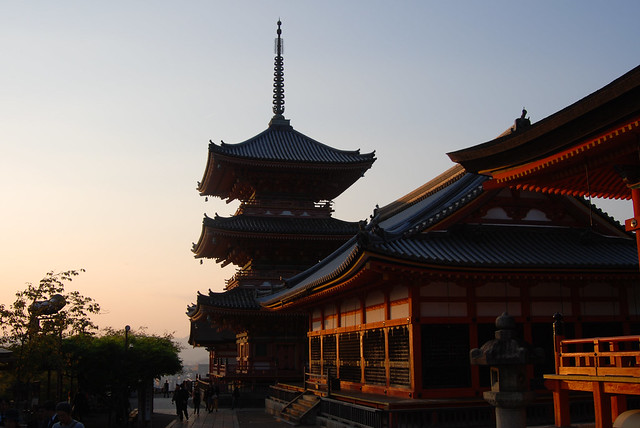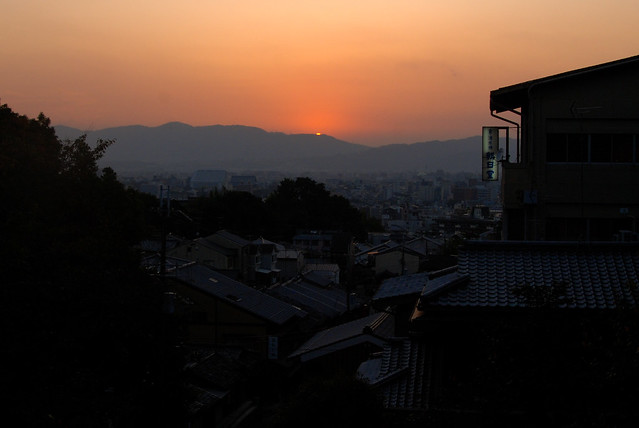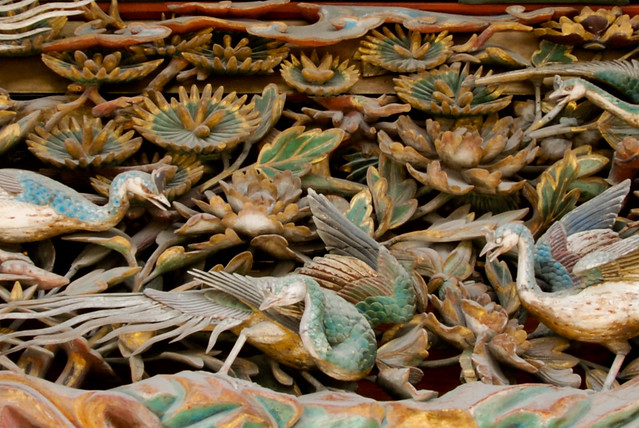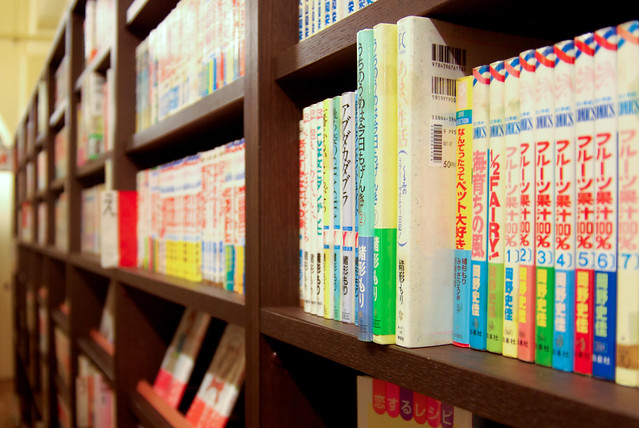(This is part of a guide to travelling Honshu on a moderate budget and in limited time. Click here for the whole series).
I arrived in Kyoto on my second day, via Shinkansen from Tokyo. You arrive at the huge JR Kyoto station, from which you can link to the local JR lines, the private railway (pass not valid) and the subway (ditto). Coming in at around 1pm I dropped my backpack in a coin locker (there are several sets – try the side of the station if the main area is full) and headed out on the local train to Inari. It’s a few stops, and trust me, you want to travel light for this one.
Fushimi Inari-taisha
The Fushimi Inari-taisha shrine complex is directly opposite the JR Inari station – look for the red Torii gate. Then look for another, up the hill. Then look for a couple of thousand of them lining the mountain path. It’s stunning.
The first torii
The path leads on and on, past dozens of shrines and some scenic views. It’s steep in places, and not something to undertake with luggage or nearing dusk. The route is signed, badly, and even with maps everywhere it can be a little baffling, but nonetheless I managed a scenic circuit taking in the very top in about two hours.
Somewhere inside the complex
Kinkaku-Ji, Sanjyu-San and Kyomizu-dera
Back in Kyoto, you can’t walk a few blocks without hitting a gorgeous-looking temple. Probably the best known, though, is the golden pavilion, Kinkaku-Ji. It’s a bus ride from Kyoto JR, or a nice walk from the nearby Kitaoji subway stop, passing a huge complex of Buddhist temples en-route. I arrived early, just after 9am, and it was already packed – walking down the approach all I could hear were cries of ‘suggeeeeeeiii!’ (roughly, ‘wow’) from schoolkids rounding the corner ahead. And it is, indeed, one hell of a view.
The Kinkaku-Ji. Just stunning.
Most of the other temples lie over the other side of town to the East, and you could easily spend a week checking them all out. With a day and a half in Kyoto, I had to hike about quite a bit. After stopping mid-way at the International Manga Museum (below) I hauled across to the Sanjyu-San – a huge, ancient, Buddhist complex containing a frankly unfeasible number of many-armed statues, plus a Buddah in the middle. No photos are allowed, but to be honest you couldn’t capture it anyhow – it’s remarkable.
The Kyomizu-dera
The Kyoto National Museum is just across the way from there, but is currently in renovation and was closed as I passed. Instead, I walked to the unfeasibly beautiful Kyomizu-dera temple up on the hill to the East. It’s possible to approach via two souvenir-shop-packed streets, but check a map for the path up through the huge cemetery below – it’s a climb, but the views are amazing. As was seeing the sun set behind the pagoda from the top of the temple.
Sunset over Kyoto. Such a beautiful place.
International Manga Museum and Nijō Jō
As well as all the temples, it’s worth checking out the famous Nijō Jō castle. It’s impressive from the outside, with elaborately carved gates, but take the tour to see the inner quarters and walk on the squeaking nightingale-floors. Also, don’t miss the inner room decorations: these are housed in a separate museum inside the castle walls (look for the modern building). Photos are forbidden inside.
Carvings on the Nijō Jō
Not far from the castle is the International Manga Museum. This is really more library than museum, but it’s a chance to grab, sit down with and read just about any manga you’ve ever heard of, and then a couple of thousand more, going back decades. Entry (800Y) is good for the day. There are a few shelves of English translations, and English signage in the exhibits, but to be honest you’ll need to a bit of Japanese (not much – lots of Manga are furiganated) to get the most from this.
Inside the International Manga Museum
The museum is housed in an old school, and a few rooms are devoted to the history of the building – these are well worth checking out.
Food, Hotels and Travel
From JR Kyoto the subway line runs directly north, then another crosses it at Karasuma-Oike station, running East-West. The rest of the city is served by buses. Both cost <200Y for most trips, but Suica or Pasmo cards won’t work (there is a local IC card). As it’s on a grid layout, walking is easy, and there are a couple of large covered shopping arcades should you need coffee, a pharmacy etc.
I stayed in the Hearton Hotel Kyoto, which is tucked away about a block from Karasuma-Oike – it’s on the sidestreet behind the big sporting goods shop. It’s a little worn (well, actually pretty knackered in places), but good value for the £55 or so it costs per night, and the location’s good for the subway. I’d recommend it.
For cheap eats there are the usual combini and fast food outlets, plus department store basement food halls on the main Shijo-Dori parade running East-West (check out the posh coffee shop that turns into a cheap curry counter by night!) and some decent ramen places for 15Y or so.
I loved Kyoto, and could have easily stayed longer – but with a public holiday on Monday, all the hotels were full, so I bailed out of town towards Northern Kansai and the onsen of Kinosaki.
